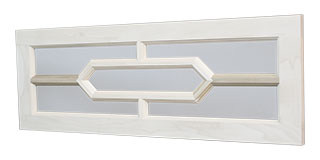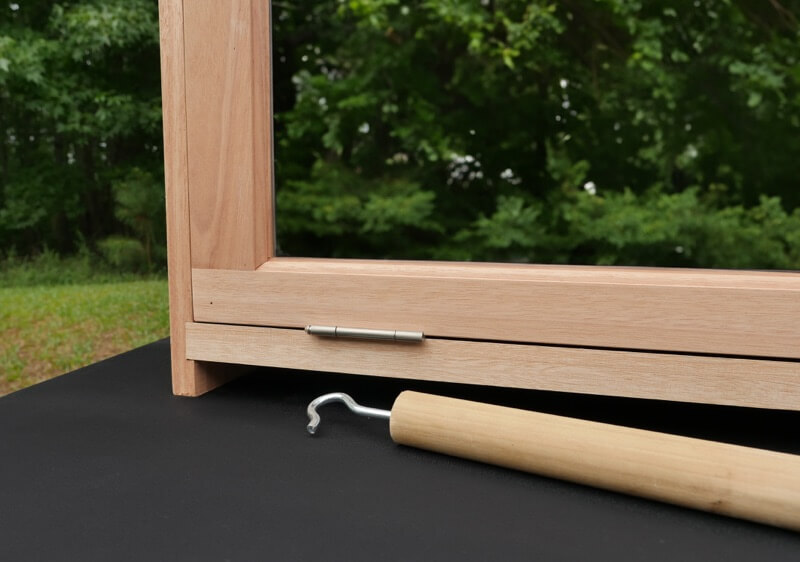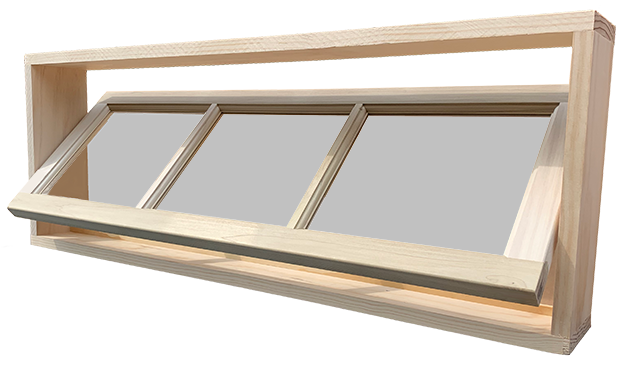Transoms 101: Learn how to size and order your transom
Order a perfect transom for your project. Watch this video to learn the terminology and resources available.
Standard Glass Information
All of our interior and exterior windows come standard with clear glass included.
- Interior transoms come standard as single-pane, true-divided-lite windows. This means each pane is a separate piece of glass.
- Exterior transoms come standard as insulated, double-pane, simulated-divided-lite windows.
For unheated applications (such as barns and garages), interior models can can be configured with single-pane glass and rot-resistant wood as a cost-effective alternative to an exterior-grade window.

Specialty Glass
Glass for both interior and exterior windows can be upgraded to specialty glass in a number of ways, including:
- Substitution of artistic glass for clear glass
- Tempering
- Adding energy coatings and tints (e.g., Low-E, bronze or grey tints)
Not all specialty glass options are available on all patterns. Check the ordering page for a specific pattern/size combination to learn what is available.
Artistic Glass
For artistic (art) glass, the surface or composition of the glass is altered to make it distinct from clear glass. The resulting appearance can be uniform (frosted), organized (fluted) random (glue chip, antique, wavy) or even obscure (seeded).
In general, clear glass helps a transom blend-in to room, artistic glass helps the transom stand out.
Art glass certainly makes a stylistic statement, but some varieties also help obscure objects behind the glass adding privacy for bathroom and bedroom applications.

Artistic Glass Options
Clear
Clear, annealed, untempered is standard on all sashes.
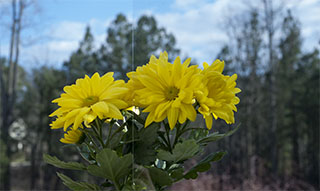
Satin / Frosted
Satin or frosted glass is made by sandblasting or acid etching a clear pane of glass. This process renders the glass translucent because the light passing through the glass is randomly scattered. Frosted glass is a good option for maximum privacy while still permitting light transmission.
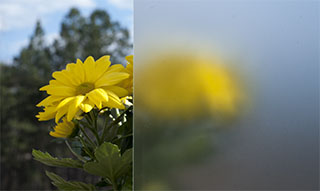
Reeded / Fluted
Reeded or fluted glass is a ribbed glass that provides good obscurity with lots of light transmission. When we assemble your transom we will run the ribs in the vertical orientation unless you give us a special instruction to run it horizontal.
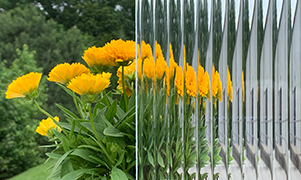
Seeded
Seeded glass (or "Seedy" Glass) is still clear, but it is intentionally "seeded" with small imperfections (gas bubbles) to give the glass more interest. Use seeded glass where you want generally clear glass with some distortion.
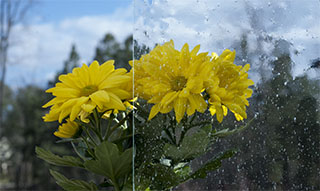
Glue Chip
Glue chip glass is a texture that looks like frost on a window pane during the winter cold. This attractive random pattern is created by applying hot glue to the sandblasted surface of clear float glass and allowing it to dry under controlled temperature and humidity conditions.
>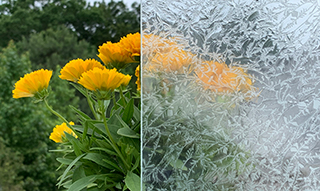
Antique
Antique glass is also still clear, but it has noticeable "running of the glass" that produces distortion. Genuine antique glass differs from modern glass in that antique glass was fabricated in a transition period between hand blowing and modern manufacturing. In this period, certain portions of old techniques were replaced with mechanical devices. The mechanical "rolling" of this period in the 19th and early 20th centuries gave this glass a unique appearance. Our modern replica glass resembles glass of this period.
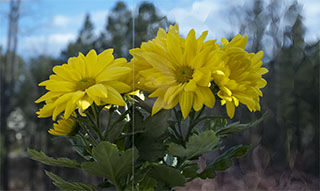
Water / Wavy
Water or wavy glass first became popular around the turn of the 20th century. It's clear but has a pattern that obscures the item behind it while leaving it largely identifiable. We see this glass used both in historical renovations and in homes that want to achieve a more slightly more elegant feel.
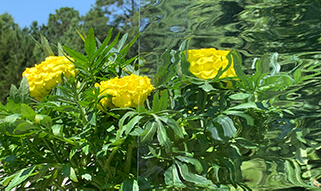
Mirrored
Mirrored glass is exactly what you think it is -- mirrored glass that replaces regular, clear glass. Choose this glass if you plan to hang a the transom sash from a wall (for decorative purposes) or if you embed the transom in a wall to simulate an exterior or room-to-room window. You can see examples of these ideas in our Houzz Gallery LINK NEEDED here.
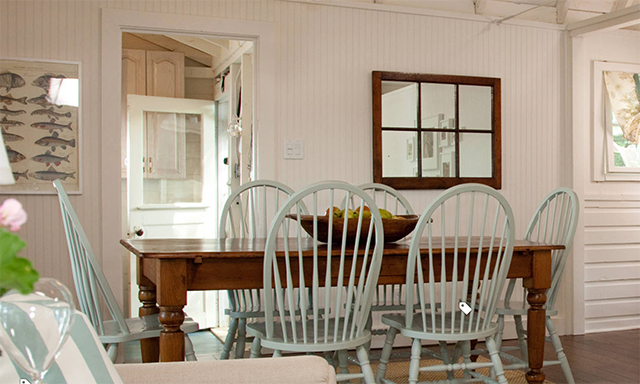
No Glass
We do occasionally have orders for transoms without glass. Most "glassless" applications involve screened porches or other areas where ventilation is required. Transoms ordered without glass will be manufactured without a glass slot. See our Sticking Profile customization for more information on sticking profiles that are available without a glass slot.
Tempered Glass
Tempered glass (also known as safety glass) is specially coated or specially formulated so that it is much stronger than regular glass and shatters in a way less likely to cause injury.
Our clear and artistic glass can be ordered tempered for your application. Be aware that all tempered glass transoms are made as simulated divided lite windows, and generally require an additional week or more to deliver since the glass has to be specially made.
Typically, tempered glass is only installed in areas where the building code requires it. These so-called "hazardous locations" are generally adjacent to doors, in stairways, halls or bathrooms.
Check your local building codes, but most locations where transom windows are installed (over doors or openings) are not considered hazardous and thus are not required to be tempered. This is because the windows are higher than the typical "plane of travel" -- that is, you can't run into them easily. Accordingly, sidelights (windows next to doors) are near the plane of travel and must be tempered. Windows in bathrooms should be verified carefully, but generally if they are 66" above a tub or shower's drain, they don't need to be tempered.
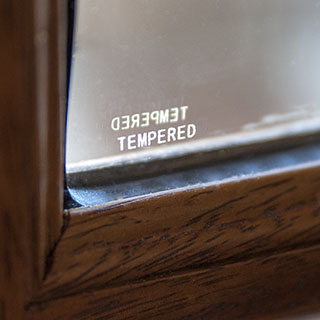
Standard Wood
Our standard windows come paint-ready and free of all but the smallest imperfections.
Interior, paint-grade sashes are generally made of Poplar and jambs are made of Pine.
Exterior, paint-grade sashes and jambs are made of a rot-restant wood like Red Grandis or Cypress.
We only fabricate windows in wood. Vinyl or steel windows are not available.
All wood transoms and jambs are carefully sanded before shipment.
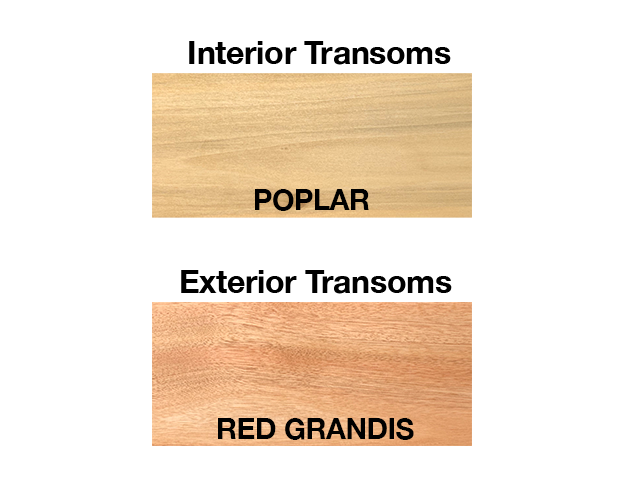
Stain-Grade Wood
We also can build your sash or jamb in a number of what we consider stain-grade wood species. We have the following stain-grade species available as standard options:
- Red Oak
- White Oak
- Maple
- Cherry
- Ash
- Alder
- Pine
- Cedar
- Cypress
- Mahogany
- Walnut
- Douglas Fir
- Red Oak - Quarter Sawn
- White Oak - Quarter Sawn
Most people who order a stain-grade sash also choose to order a stain-grade jamb, if needed. However, our system does allow stain grade sashes to be ordered with paint-grade jambs if that is your preference.

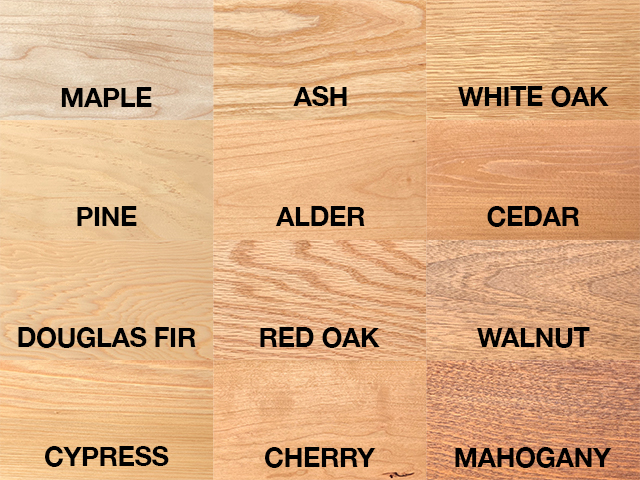
Special notes on Stain-Grade Wood
Some types of wood are machined differently -- so not all transom designs are available in all wood species. The ordering page will show wood species available for the pattern selected.
If you do not see your favorite wood selection in our options list, please call. We can source most any wood species. Just know that some exotic species may be more expensive, harder to machine, or require a longer lead time. We will price and evaluate special requests on a per order basis.
Staining and Painting our Windows
Wood samples shown in the picture have been finished with one coat of clear polyurethane. If you plan on using a different stain color (other than clear coat), we recommend testing it on the outside edge of the sash or jamb to obtain the correct mix BEFORE attempting to stain the transom unit.
All of our transom windows (interior and exterior) are delivered un-painted and un-stained. We do not offer painting or priming for our windows. Our installation section has detailed tips about preparing and painting or staining your transom.
What is a Sticking Profile?
Sticking is the edge profile on the wood immediately adjacent to the glass.
For window makers this transition is called a sticking profile, and the profile can be carved into different shapes.

Standard Sticking Profile
The traditional Beaded profile is our standard sticking profile.
Probably 90% or more of all windows ever manufactured have this profile, and it is our standard as well.
Unless you are trying to match a specific profile listed below, you are best going with this standard profile.
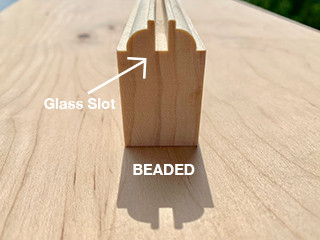
Optional Sticking Profiles
You may desire to match your transom to the sticking profile of adjacent wood windows, sidelites or french doors. Again, those items are likely to match our Beaded profile. If not, we offer additional options below:
The Ogee profile is similar to the "Ovulo" profile common to Colonial or Williamsburg style homes in the northeast United States. Our Ogee is nearly identical to our Beaded profile, but the part of the Ogee profile closest to the glass is rounded instead of squared. Our advice: unless you know you are matching the Ogee profile to something else in your project -- order the Beaded profile instead.
The Beveled profile matches the style of Arts & Crafts windows. Model numbers for our Arts & Crafts transoms always start with "AC." Instead of a "bead," the "beveled" transition is a single, simple 45 degree angle that clips the 90 degree turn. You occasionally see this profile on Bungalow and Mission style windows as well (look for "BM" patterns).
The Square profile matches the style of Shaker doors, furniture and cabinets. If you have Shaker elements in your home, consider this Square profile on a TR-1 or TR-4 pattern. This profile does not look good with patterns that have curved muntins.

No Glass Sticking Profiles
If you order your transom with no glass, the transom will come to you with no glass slot. Such "no glass" transoms are typically used for ventilation or decorative purposes.
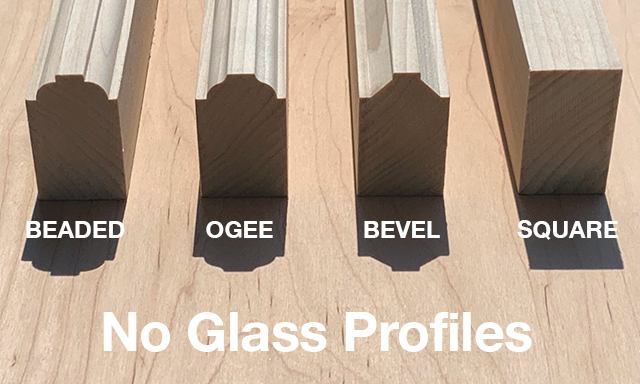
General Information
First, some general information so you can understand terminology used in the FAQ below.
The pieces comprising the wood perimeter of the transom sash have names. The top and bottom pieces are called rails. The side pieces are called stiles.
So the height of a transom sash is composed of the height of the rails at the top and bottom plus the height of glass sandwiched in between.
Likewise the sash width is the sum of the width of the stiles plus the area between them that is filled with glass and muntins.
Frequently Asked Questions
The size I need is not listed, or it says I have to call. What should I do?
I plan to order an operable transom, how does this affect size I can order?
What is the difference between standard and custom sizes?
How do I tell if I have a custom size, and why do some custom sizes cost so much?
How accurate are your custom sizes?
How close is the look of the black and white line drawing of the transom to what I will receive?













